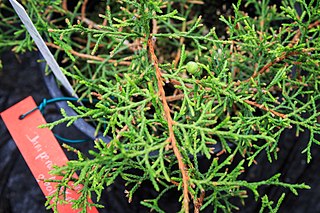
Magnolia is a large genus of about 210 to 340 flowering plant species in the subfamily Magnolioideae of the family Magnoliaceae. The natural range of Magnolia species is disjunct, with a main center in east and southeast Asia and a secondary center in eastern North America, Central America, the West Indies, and some species in South America.

Magnolia grandiflora, commonly known as the southern magnolia or bull bay, is a tree of the family Magnoliaceae native to the Southeastern United States, from Virginia to central Florida, and west to East Texas. Reaching 27.5 m (90 ft) in height, it is a large, striking evergreen tree, with large, dark-green leaves up to 20 cm long and 12 cm wide, and large, white, fragrant flowers up to 30 cm (12 in) in diameter.

Plumeria, also known as frangipani, is a genus of flowering plants in the subfamily Rauvolfioideae, of the family Apocynaceae. Most species are deciduous shrubs or small trees. The species are native to the Neotropical realm, but are often grown as cosmopolitan ornamentals in tropical regions, especially in Hawaii, as well as hot desert climates in the Arabian Peninsula with proper irrigation.

Mammea americana, commonly known as mammee, mammee apple, mamey, mamey apple, Santo Domingo apricot, tropical apricot, or South American apricot, is an evergreen tree of the family Calophyllaceae, whose fruit is edible. It has also been classified as belonging to the family Guttiferae Juss. (1789), which would make it a relative of the mangosteen.

Juniperus gracilior is a species of conifer in the cypress family, Cupressaceae. It is endemic to the Caribbean island of Hispaniola, where there are localized populations in both Haiti and the Dominican Republic.
Eleutherodactylus counouspeus, also known as Counou robber frog and yellow cave frog, is a species of frog in the family Eleutherodactylidae. It is endemic to the Massif de la Hotte, southwestern Haiti. The specific name counouspeus refers to its type locality, Counou Bois Cave, with speus being Greek for "cave". Hedges and colleagues suggested in 2008 that it should be placed in its own monotypic subgenus, Schwartzius, reflecting its distinctiveness and honoring Albert Schwartz for "his contributions to the herpetology of the West Indies."

Casasia is a genus of flowering plants in the family Rubiaceae. These shrubs or small trees occur on the Caribbean islands and in one case in Florida. Some of the ten accepted species were formerly placed elsewhere, e.g. in the related genip-tree genus (Genipa), in Gardenia or in Randia.

Wallenia is a genus of flowering plants in the family Primulaceae endemic to the West Indies. It is composed of 29 species. It also includes a subgenus, Homowallenia, with ten species from the northern Caribbean.
The Massif de la Hotte is a mountain range in southwestern Haiti, on the Tiburon Peninsula. About 2.5 million years ago, Massif de la Hotte was separated from the Massif de la Selle by a deep, wide sea channel, and formed a separate island. This resulted in a hotbed of endemism in la Hottes bird, plant, and reptile communities. The Massif de la Hotte is subdivided into the Oriental la Hotte in the East, the central la Hotte and the Occidental la Hotte on the Western tip of the Tiburon peninsula. The Occidental la Hotte is relatively remote and is one of the most biologically diverse and significant areas of all of Hispaniola. It also supports some of the last stands of Haiti's dense cloud forest on its peaks.

Coccothrinax ekmanii, also known in Haitian Creole as gwenn or in Dominican Spanish as palma de guano, is an endangered species of palm which is endemic to the island of Hispaniola.

Copernicia ekmanii is a palm which is endemic to northern Haiti.
Anastraphia is a genus of flowering plants in the family Asteraceae. It includes 33 species native to the Caribbean, including Cuba, Hispaniola, the Bahamas, and the Turks and Caicos Islands.

Cleyera is a plant genus consisting of 21 species of tender, evergreen shrubs to small trees, mostly native to Mexico and Central America, and one from Eastern Asia. In the APG III system it is placed in the family Pentaphylacaceae.
Haiti National Trust is an international, non-governmental, and non-profit environmental organization dedicated to protecting the biodiversity of Haiti. The Haiti National Trust seeks to establish more protected areas, including national parks, and to stop the destruction of forests, which is the primary cause of species loss in Haiti. The trust also advocates protection of the country's fragile coral reefs and coastal ecosystems. It was founded in 2015 by Philippe Bayard, president and founding member of the Audubon Society of Haiti, and S. Blair Hedges, Laura H. Carnell Professor and director of the Center for Biodiversity at Temple University.

Grand Bois National Park is a national park in Haiti. It was established on September 23, 2015, by Haitian president, Michel Martelly. The park is located in southwest Haiti, northwest of Les Anglais and it includes all areas on the mountain Morne Grand Bois of 900 meter elevation and higher. Morne Grand Bois sits directly on the border between the Sud department and the Grand'Anse department. Its highest peak is 1262 meters in elevation. Morne Grand Bois is an isolated mountain with remnant original (primary) rainforest.
Magnolia tarahumara is a species of flowering plant in the family Magnoliaceae. It is endemic to Mexico, where it occurs in scattered locations in the Sierra Madre Occidental of southeastern Sonora, southwestern Chihuahua, Sinaloa, and northwestern Durango.

Wercklea hottensis is a species of Malvaceae endemic to the mountains of the Massif de la Hotte in South-Western Haiti.
Frodinia tremula is a species of plant in the family Araliaceae. It is a scrambling tree endemic to the island of Hispaniola.












